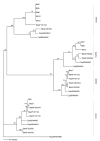Detection of potentially valuable polymorphisms in four group I intron insertion sites at the 3'-end of the LSU rDNA genes in biocontrol isolates of Metarhizium anisopliae
- PMID: 16978412
- PMCID: PMC1578565
- DOI: 10.1186/1471-2180-6-77
Detection of potentially valuable polymorphisms in four group I intron insertion sites at the 3'-end of the LSU rDNA genes in biocontrol isolates of Metarhizium anisopliae
Abstract
Background: The entomopathogenic anamorphic fungus Metarhizum anisopliae is currently used as a biocontrol agent (BCA) of insects. In the present work, we analyzed the sequence data obtained from group I introns in the large subunit (LSU) of rDNA genes with a view to determining the genetic diversity present in an autochthonous collection of twenty-six M. anisopliae isolates selected as BCAs.
Results: DNA fragments corresponding to the 3'-end of the nuclear LSU rDNA genes of 26 M. anisopliae isolates were amplified by PCR. The amplicon sizes ranged from 0.8 to 3.4-kb. Four intron insertion sites, according to Escherichia coli J01695 numbering, were detected--Ec1921, Ec2066, Ec2449 and Ec2563--after sequencing and analysis of the PCR products. The presence/absence of introns allowed the 26 isolates to be distributed into seven genotypes. Nine of the isolates tested showed no introns, 4 had only one, 3 two, and 10 displayed three introns. The most frequent insertion sites were Ec1921 and Ec2449. Of the 26 isolates, 11 showed insertions at Ec2563 and a 1754-bp sequence was observed in ten of them. The most-parsimonious (MP) tree obtained from parsimony analysis of the introns revealed a main set containing four-groups that corresponded to the four insertion sites.
Conclusion: Four insertion sites of group I introns in the LSU rDNA genes allowed the establishment of seven genotypes among the twenty-six biocontrol isolates of M. anisopliae. Intron insertions at the Ec2563 site were observed for first time in this species.
Figures

Similar articles
-
Genetic analyses place most Spanish isolates of Beauveria bassiana in a molecular group with word-wide distribution.BMC Microbiol. 2011 Apr 26;11:84. doi: 10.1186/1471-2180-11-84. BMC Microbiol. 2011. PMID: 21521527 Free PMC article.
-
Nuclear large subunit rDNA group I intron distribution in a population of Beauveria bassiana strains: phylogenetic implications.Mycol Res. 2003 Oct;107(Pt 10):1189-200. doi: 10.1017/s0953756203008505. Mycol Res. 2003. PMID: 14635767
-
Polymorphism in Metarhizium anisopliae var. anisopliae (Hypocreales: Clavicipitaceae) based on internal transcribed spacer-RFLP, ISSR and intron markers.Genet Mol Res. 2011;10(3):1565-75. doi: 10.4238/vol10-3gmr1069. Genet Mol Res. 2011. PMID: 21863552
-
Identification of group-I introns at three different positions within the 28S rDNA gene of the entomopathogenic fungus Metarhizium anisopliae var. anisopliae.Fungal Genet Biol. 2000 Nov;31(2):79-90. doi: 10.1006/fgbi.2000.1232. Fungal Genet Biol. 2000. PMID: 11170737
-
IGS sequence variation, group-I introns and the complete nuclear ribosomal DNA of the entomopathogenic fungus Metarhizium: excellent tools for isolate detection and phylogenetic analysis.Fungal Genet Biol. 2003 Mar;38(2):159-74. doi: 10.1016/s1087-1845(02)00536-4. Fungal Genet Biol. 2003. PMID: 12620253
Cited by
-
Genetic analyses place most Spanish isolates of Beauveria bassiana in a molecular group with word-wide distribution.BMC Microbiol. 2011 Apr 26;11:84. doi: 10.1186/1471-2180-11-84. BMC Microbiol. 2011. PMID: 21521527 Free PMC article.
-
Occurrence and characteristics of group 1 introns found at three different positions within the 28S ribosomal RNA gene of the dematiaceous Phialophora verrucosa: phylogenetic and secondary structural implications.BMC Microbiol. 2011 May 8;11:94. doi: 10.1186/1471-2180-11-94. BMC Microbiol. 2011. PMID: 21548984 Free PMC article.
-
Metarhizium caribense sp. nov., a Novel Species of Entomopathogenic Metarhizium Fungi Associated with Weevils Impairing Coffee, Sugar Cane and Sweet Potato Cultivation.J Fungi (Basel). 2024 Aug 28;10(9):612. doi: 10.3390/jof10090612. J Fungi (Basel). 2024. PMID: 39330372 Free PMC article.
References
-
- Gillespie AT, Claydon N. The use of entomopathogenic fungi for pest control and the role of toxins in pathogenecis. Pest Sci. 1989;27:203–215.
-
- Zimmermann G. The entomopathogenic fungus Metarhizium anisopliae and its potential as a biocontrol agent. Pest Sci. 1993;37:375–379.
-
- Gillespie A, Moorhouse ER. The use of fungi to control pests of agricultural and horticultural importance. In: Whipps JM, Lumsden RD, editor. Biotechnology of fungi for improving plant growth. UK: Cambridge University Press; 1989. pp. 55–84.
-
- Veen KH. Recherches sur la maladie, due à Metarhizium anisopliae chez le criquet pèlerin. Mededelingen Landbouwhoge-school Wageningen, Nederland. 1968;68:407–411.
Publication types
MeSH terms
Substances
LinkOut - more resources
Full Text Sources

